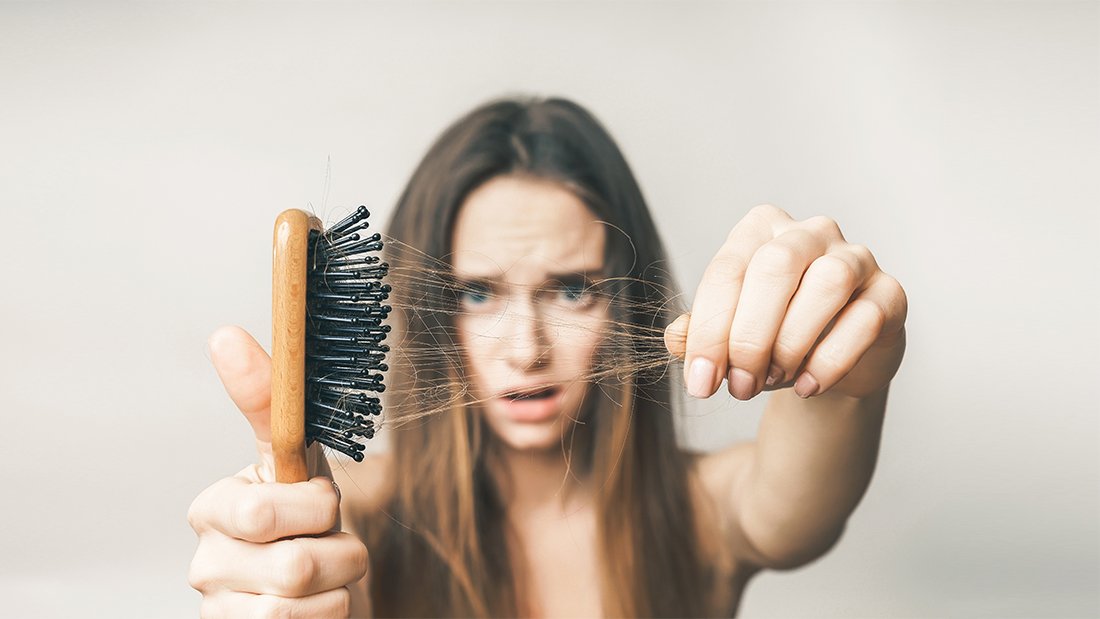Can Male Pattern Baldness Be Reversed
Androgenetic alopecia, also known as male pattern baldness, is the most common cause of hair loss in men.
Hair loss from male pattern baldness can be slowed down at the early stages, but it cannot be reversed or cured.
Some treatments, such as PRP injections and minoxidil, effectively slow down the progression of male pattern baldness and even help to regrow some hair. But this is often when treatment is received at the early stages of the condition only.
Because androgenetic alopecia damages hair follicles, once these cease to work, hair regrowth is not possible. In other words, once the man is completely bald in one area or in most of his scalp, male pattern baldness is not reversible at all.
Man with advanced stages of androgenetic alopecia.
Can I Stop Hair Loss
How do I stop hair loss? is a pretty common question for guys to ask when they notice their thinning hair or a newly receding hairline. The problem is that depending on who you ask , the answer can be different.
Well, youre in luck today, my friend. Because everything you read on Keeps is expert-backed by leading hair loss experts .
Unfortunately, the answer to How do I stop hair loss? isnt an easy yes or no. We know, we knowwe also wish our bodies werent so complex.
So, before we tell you how to stop hair loss, were going to walk through some commonly asked questions to help you better under why its not so simple.
How Long Will It Take For My Hair To Grow Back
Although no immediate effect may be seen after your first month of taking finasteride, it is highly recommended that you stick with it for a few months as long as you suffer no adverse reactions.
It can take at least three months to slow down hair loss, six months to grow new hair, and as long as 12 months to verify whether the treatment is effective for you.
Even though the struggle to stop hair loss may be a long battle, the good news is that more than 90% of those taking finasteride reported seeing desirable results . While the effectiveness of finasteride often depends on the length of time it is taken, the available evidence suggests that two thirds of men who use it see some hair regrowth.
If you stop taking finasteride, it is likely that any hair you gained will be lost within 9-12 months.
Also Check: Can You Reverse Thinning Hair
Don’t Be Embarrassed Get Medical Advice Online
Does the thought of talking to a doctor face to face about hair loss make you feel uncomfortable? If so, you can register with us and seek professional advice from our GPs without having to step into a clinic or book an appointment. Propecia or Finasteride can either be delivered to your home or collected from your local LloydsPharmacy store.
References
Get A Professional Hair And Scalp Analysis

Sometimes, it can be difficult to determine why your hair is falling out and therefore, how to treat or prevent hair loss. In addition to reviewing your medical history and asking about lifestyle factors that may be affecting the health of your hair, a dermatologist can perform a professional hair and scalp analysis to help determine the cause of your hair loss. Your dermatologist will carefully study your hair and scalp and may take a sample of your hair or a scalp biopsy to gather more information.
Don’t Miss: Can Lupus Cause Hair Loss
Signs Of Balding: How To Stop Hair Loss
Medically reviewed by Kristin Hall, FNP
Like most signs of aging, androgenetic alopecia, also known as male pattern baldness, doesnt happen overnight. In fact, for most men, going bald is a gradual process.
If youre wondering how to avoid hair loss, one of the keys is learning about the common signs of baldness and taking action as early as possible. Simply put, the earlier you take action to prevent hair loss, the more hair youll be able to save.
Unfortunately, identifying hair loss isnt always easy. With many myths about balding circling the internet, it is easy to mistake normal hair loss for male pattern baldness.
Luckily, there are some real signs of male pattern hair loss that you can use to identify and deal with hair loss.
How Is Hair Loss Treated
If your hair loss results from medication, hormonal imbalances, thyroid disease or diet, your provider will address the cause. Correcting the underlying problem is often all thats needed to help stop hair loss.
Most hair loss treatments are meant to help with androgenic alopecia . These treatments include:
- Medication: Over-the-counter medications you apply to your scalp are usually the first course of treatment for thinning hair. A prescription oral medication is approved only for men with male pattern baldness.
- Hair transplant: During a hair transplant, your provider carefully removes strands of hair from an area of your scalp where the hair is thickest. The provider then transplants those strands, embedding them into your scalp where your hair is thinnest.
- Platelet-rich plasma : After drawing your blood, your provider separates out the plasma. They then inject this platelet-rich plasma into your scalp. PRP treatment can help slow hair loss and encourage new hair growth.
Also Check: What Is Best For Hair Loss
The Other Proven Option For Men Is The Oral Tablet Finasteride Known By Its Brand Name Propecia The Drug Can Stop Hair Loss And Stimulate Hair Growth But It Has Some Side Effects
The drug blocks the effects of male hormones on the hair follicles, and is taken daily.
Usually, patients can see it start working in 6 to 8 months, but it can also decrease sex drive, increase breast size, and contribute to erectile dysfunction, according to Merck Manuals. It’s also dangerous for pregnant women to touch the crumbly pill powder.
Whos At Risk Of Male Pattern Baldness
Male pattern baldness is genetic, so you dont need a crystal ball to gauge your personal risk. If your old man is bald, its a question of when, not if. Hair loss can start in your teens, but its more common in adulthood, with the likelihood increasing as you age. The size and shape of your head can contribute to how quickly DHT shrinks your follicles.
Also Check: Can You Prevent Hair Loss
Signs Of Early Hair Loss In Men And Women
Being aware of your hairs health and its growth pattern is the first step to getting ahead of hair loss.
Ask yourself: Are there more strands of hair falling out in your hair brush than normal? Is there a large amount of hair on your pillow when you wake up in the morning?
Visual cues are a great way to determine if youre beginning to lose more hair than normal.
For men, thinning hair usually starts with either a receding hairline or thinning at the crown of the head.
Women on the other hand begin to notice thinning hair around their part, as it gradually becomes wider. They may also notice that when their hair is pulled back they are able to see more of the scalp than before.
If you notice scalp irritation like dry or flaky skin, discoloration like red skin, or you begin to see small bald patches appear on your scalp, you should go to the doctor immediately so that he or she can assess the situation. This type of hair loss can be a reaction to something else going on with your body.
Seeing any of these signs can cause serious concern, especially at a young age. Stressing yourself out however, isnt going to do your hair any good.
While we understand the emotional toll hair loss can cause, there are still plenty of options available to you. Again, be sure to look for early signs so you can potentially reverse what is happening to your hair.
Donât Miss: Can Dermatologist Treat Hair Loss Problem
Key Points About Normal Hair Loss
Image credit: Canva
Don’t Miss: Who Do You See For Hair Loss
What Support Is Available With Hereditary Hair Loss
Hereditary hair loss is a normal part of the ageing process. However, when baldness occurs suddenly or early in life it can be distressing. Hair loss is particularly upsetting for women. Talking with others who have experienced hair loss may help. If you need to talk to someone, ask your doctor about counselling sessions available in your area or for a referral to a counsellor.
Below are also some support groups you may find helpful.
NZ Alopecia Facebook support groupNZ Alopecia website Information from fellow New Zealanders living with alopecia. Links to support groups, personal experiences through to information about wig subsidy.Wigs and hairpieces subsidy Information from the Ministry of Health regarding wigs and hairpieces subsidy for people who suffer from serious hair loss because of a medical condition or from certain cancer therapies.
What Is Common Baldness

Common baldness usually means male-pattern baldness, or permanent-pattern baldness. The medical term for this is androgenetic alopecia. Male-pattern baldness is the most common cause of hair loss in men. Men who have this type of hair loss usually have inherited the trait. Men who start losing their hair at an early age tend to develop more extensive baldness. In male-pattern baldness, hair loss typically results in a receding hairline and baldness on the top of the head.
Women may develop female-pattern baldness. In this form of hair loss, the hair can become thin over the entire scalp.
Read Also: How To Correct Hair Loss
What Questions Should I Ask My Doctor
You may want to ask your healthcare provider:
- What is causing my hair loss?
- Do I need to change any of my current medications?
- What are the best treatments for my type of hair loss?
- Am I a good candidate for hair transplant?
- Is there a treatment that will help me regrow hair?
A note from Cleveland Clinic
Hair loss from any cause can be emotionally challenging. Talk to your healthcare provider about what may be causing your hair loss. In many cases, effective treatments exist that can slow hair loss and help spur new hair growth. And many people find ways to thrive and feel great, no matter how much or how little hair they have.
Can I Sunbathe Following A Hair Transplant
Unfortunately for any sun-seekers out there, we advise against sunbathing for the first few weeks after a hair transplant, for several reasons. After an FUE or FUT hair transplant, your scalp will have surgical incisions that need time to heal. Exposing the incisions to sunlight can hinder the healing process and damage the deeper layers of the scalp tissue, potentially leading to scarring and damaged follicles.
Your scalp also may feel slightly numb after your surgery, meaning that if your scalp starts to burn under the suns harmful rays, you might not notice in time to protect yourself from sunburn. Although it is unlikely to impact the long-term results of your surgery, it can be painful and slow down the recovery process.
If you must sit in the sun, wear a loose sun hat that doesnt rub against your scalp too much, and, once the incisions have healed, use sunscreen on your scalp to protect your skin.
Don’t Miss: Does Weed Cause Hair Loss
What Are The Results Of Body Hair Transplants
Its worth noting that often body hair transplants do have a lower success rate than typical hair transplants, partially due to the lower levels of compatibility between the hairs on the head and the hairs on the body and the different structures of the hairs. However, during your consultation you will be able to discuss any potential issues with your surgeon.
To find out more about body hair transplants and to find out if you may be a suitable candidate for the surgery, get in touch with Crown Clinic.
Hair Cycle Of Growth And Rest
Like your skin and nails, your hair goes through a finely tuned cycle of growth and rest. Hair loss can occur at any time in the cycle. There are 3 phases in a hair cycle:
- In the first stage, your scalp hair is continually growing. This is called the anagen phase. In this phase, your hair grows about 12cm per month. About 90% of your hair is in this stage at any one time. It lasts between 25 years.
- The second stage is call the catagen phase, which is when growth stops. About 13% of your scalp hair is in this phase at any one time. It lasts for 23 weeks.
- The third stage is called the telogen phase. This is a resting phase and it lasts between 14 months. About 10% of your scalp hair is in this phase at any one time.
At the end of its resting stage, a hair goes through a shedding phase, which normally results in the growth of a new hair. When a hair is shed, it’s replaced by a new hair from the same hair follicle, located just beneath your skin surface.
Male or female hereditary hair loss is caused by genetic or hormonal influences. It is also called androgenic alopecia because it is affected by the hormones called androgens. These are present in both men and women, but in different quantities.
Your risk of hereditary hair loss increases if you have relatives who have experienced hair loss. Your genetic blueprint for hair loss will affect things like:
- how old you are when hair loss begins
- how fast you lose hair
- the pattern and extent of your hair loss/ baldness.
Read Also: How To Make Thin Hair Look Thicker
What Are The Types Of Hair Loss
There are three: anagen effluvium, telogen effluvium and FPHL.
- Anagen effluvium: This is caused by medications that poison a growing hair follicle .
- Telogen effluvium: This is caused by an increased number of hair follicles reaching the telogen phase, which is the stage where hair falls out.
- Androgenetic alopecia/female pattern alopecia/female pattern hair loss /baldness: This type is the most common. Hair thins over the top of the head and on the sides.
Change Your Hair Products
There is some evidence that many gels and other styling products may contribute to hair loss, as the chemicals within these products stay on the scalp and become trapped in the follicles, preventing the hair from coming to the surface. Avoid excessive use of hair gels and try more natural styling products, which contain fewer chemicals.
Also Check: Can Your Hair Grow Back After Thinning
How To Prevent Hair Loss: 5 Ways To Avoid It
While aging is a factor, genetics are the real determining metric for most men’s hair density over time.
Hair loss for most men, called androgenic alopecia or male pattern baldness, is largely a result of hormones working against your hair follicles, reducing their ability to grow strong, long hair over time.
Depending on those inherited traits, you may experience hair loss as soon as your 20s, and men often see hair loss begin in their 30s.
While you cant change your genetics, there are treatment options and lifestyle practices that can help combat hair loss. The best thing is to start these preventive practices sooner than later.
Dietary Protein Is Important

Hair is made up of a form of protein , the same one found in fingernails and toenails. There are also a number of other chemical substances such as calcium, copper, zinc and iron as well as a small amount of fat in hair.Everyone, regardless of age, should eat enough protein to maintain normal hair production. Protein is found in meat, chicken, fish, eggs, some cheese, dried beans, tofu, grains and nuts.
Don’t Miss: How To Control Hair Thinning
Can Hair Loss In Women Be Prevented And If So How
Losing your hair is one of the worst things any person can go through, but for women, in particular, it can feel a lot worse, because hair loss is normally associated with men.
All women dread having thin, patchy hair. Our hair is a symbol of our identify, especially for women, and although there isnt a cure for hair loss, there are ways that it can be treated and prevented.
How To Fight Genetic Hair Loss
Most men and women will notice gradual hair loss as they age, or experience hair thinning. But according to a 2019 article published by Harvard Medical School, four in 10 people will experience hair loss due to their genetics.
How will you know if your hair loss is inherited or a result of stress or disease? Genetic hair loss, also known as hereditary pattern baldness, almost always affects your hairline up to the middle of the top of your head, John Kahan, MD, a hair restoration specialist in Beverly Hills, California tells WebMD Connect to Care.
Men may experience pronounced hair loss that starts at the temples or hairline and proceeds in an M-shaped pattern. A womanâs genetic hair loss often is less obvious but more widespread.
On the other hand, if you are losing hair from the back of your head or in clumps or patches, then itâs almost certainly not a hereditary factor and needs a doctorâs attention, says Kahen.
Also Check: How To Hide Thinning Hair